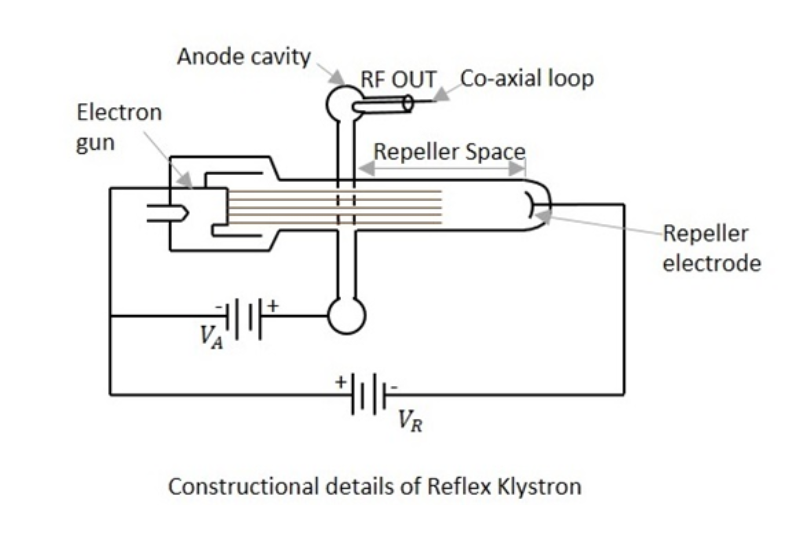1. What is a Reflex Klystron?
Definition: A reflex klystron is a low-power microwave vacuum tube used as an oscillator in RF applications. It operates by modulating an electron beam in a single resonant cavity, with the beam reflected back by a repeller electrode to sustain oscillations.
Purpose: This calculator determines key performance parameters of a reflex klystron, including output power, repeller voltage, and electronic efficiency, which are essential for designing microwave oscillators in applications like radar and communication systems.
2. How Does the Calculator Work?
The calculator uses the following formulas for reflex klystron parameters:
Output Power:
\[
\text{Output Power} = \frac{0.398 \cdot V_o \cdot I_o}{N}
\]
Repeller Voltage:
\[
\text{Repeller Voltage} = 6.74 \times 10^{-6} \cdot f \cdot L \cdot \frac{\sqrt{V_o}}{N} - V_o
\]
Electronic Efficiency:
\[
\text{Electronic Efficiency} = \frac{0.398}{N} \times 100
\]
Where:
- Output Power: In watts (W)
- Repeller Voltage: In volts (V)
- Electronic Efficiency: In percentage (%)
- \( V_o \): Beam voltage (in volts, V)
- \( I_o \): Beam current (converted to amperes from A or mA)
- \( N \): Mode number (unitless, typically an integer ≥ 1)
- \( f \): Operating frequency (converted to Hz from Hz, kHz, MHz, or GHz)
- \( L \): Distance between cavity and repeller (converted to meters from m or mm)
Steps:
- Enter the beam voltage \( V_o \), beam current \( I_o \), mode number \( N \), operating frequency \( f \), and distance \( L \), selecting their units.
- Click "Calculate" to compute the output power, repeller voltage, and electronic efficiency.
- Results are displayed in watts, volts, and percentage, respectively.
3. Importance of Reflex Klystron Calculations
Reflex klystron calculations are crucial for:
- Microwave Oscillator Design: Ensures optimal performance in RF applications like radar and communication systems.
- Efficiency Optimization: Determines the electronic efficiency to assess power usage.
- Frequency Control: Calculates the repeller voltage needed for specific operating frequencies and modes.
4. Using the Calculator
Examples:
- Example 1: Typical Reflex Klystron
- \( V_o = 300 \, \text{V}, I_o = 20 \, \text{mA}, N = 2, f = 10 \, \text{GHz}, L = 2 \, \text{mm} \)
- Convert: \( I_o = 0.02 \, \text{A}, f = 10 \times 10^9 \, \text{Hz}, L = 0.002 \, \text{m} \)
- Output Power: \( \frac{0.398 \times 300 \times 0.02}{2} = 1.194 \, \text{W} \)
- Repeller Voltage: \( (6.74 \times 10^{-6} \times 10 \times 10^9 \times 0.002 \times \frac{\sqrt{300}}{2}) - 300 \approx -187.25 \, \text{V} \)
- Electronic Efficiency: \( \frac{0.398}{2} \times 100 = 19.90 \, \% \)
- Example 2: Higher Mode
- \( V_o = 500 \, \text{V}, I_o = 10 \, \text{mA}, N = 3, f = 5 \, \text{GHz}, L = 1.5 \, \text{mm} \)
- Convert: \( I_o = 0.01 \, \text{A}, f = 5 \times 10^9 \, \text{Hz}, L = 0.0015 \, \text{m} \)
- Output Power: \( \frac{0.398 \times 500 \times 0.01}{3} \approx 0.663 \, \text{W} \)
- Repeller Voltage: \( (6.74 \times 10^{-6} \times 5 \times 10^9 \times 0.0015 \times \frac{\sqrt{500}}{3}) - 500 \approx -374.75 \, \text{V} \)
- Electronic Efficiency: \( \frac{0.398}{3} \times 100 \approx 13.27 \, \% \)
- Example 3: Different Units
- \( V_o = 400 \, \text{V}, I_o = 0.015 \, \text{A}, N = 1, f = 8 \, \text{GHz}, L = 0.001 \, \text{m} \)
- Output Power: \( \frac{0.398 \times 400 \times 0.015}{1} = 2.388 \, \text{W} \)
- Repeller Voltage: \( (6.74 \times 10^{-6} \times 8 \times 10^9 \times 0.001 \times \frac{\sqrt{400}}{1}) - 400 \approx -321.92 \, \text{V} \)
- Electronic Efficiency: \( \frac{0.398}{1} \times 100 = 39.80 \, \% \)
5. Frequently Asked Questions (FAQ)
Q: What is a reflex klystron used for?
A: A reflex klystron is used as a low-power microwave oscillator in applications like radar receivers, local oscillators in communication systems, and frequency-modulated transmitters.
Q: Why is the mode number \( N \) important?
A: The mode number \( N \) determines the transit time of electrons in the repeller space, affecting the frequency of oscillation and efficiency of the klystron.
Q: How does unit conversion work in the calculator?
A: The calculator converts beam current to amperes (e.g., 1000 mA = 1 A), frequency to Hz (e.g., 1 GHz = \( 10^9 \) Hz), and distance to meters (e.g., 1000 mm = 1 m) for calculations.
Reflex Klystron Calculator© - All Rights Reserved 2025
 Home
Home
 Back
Back
